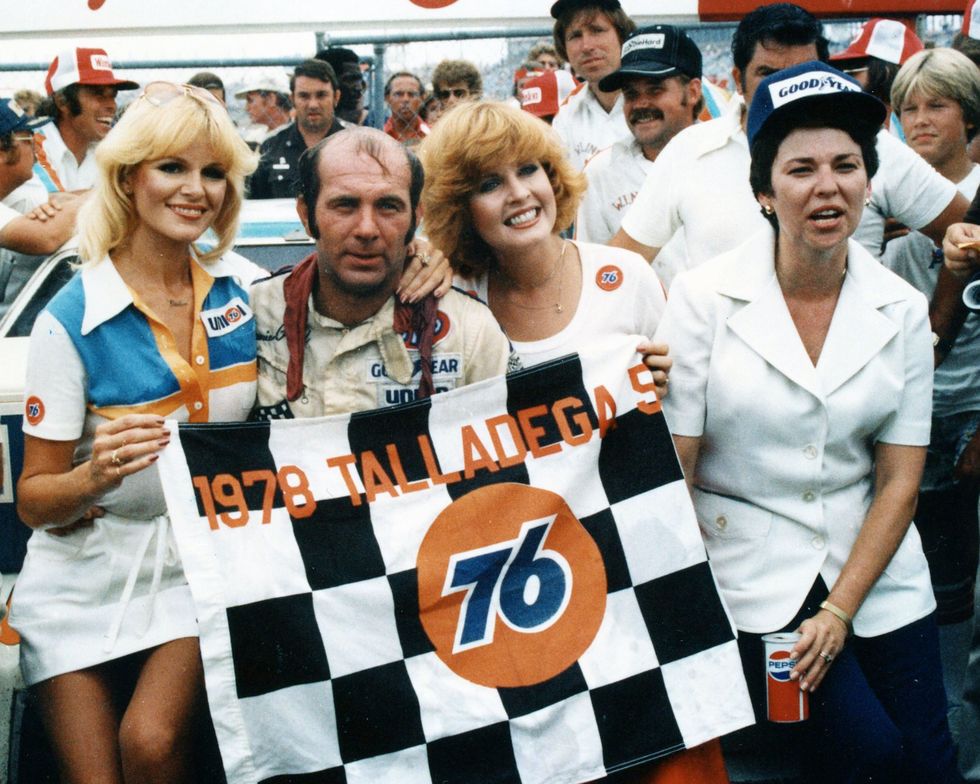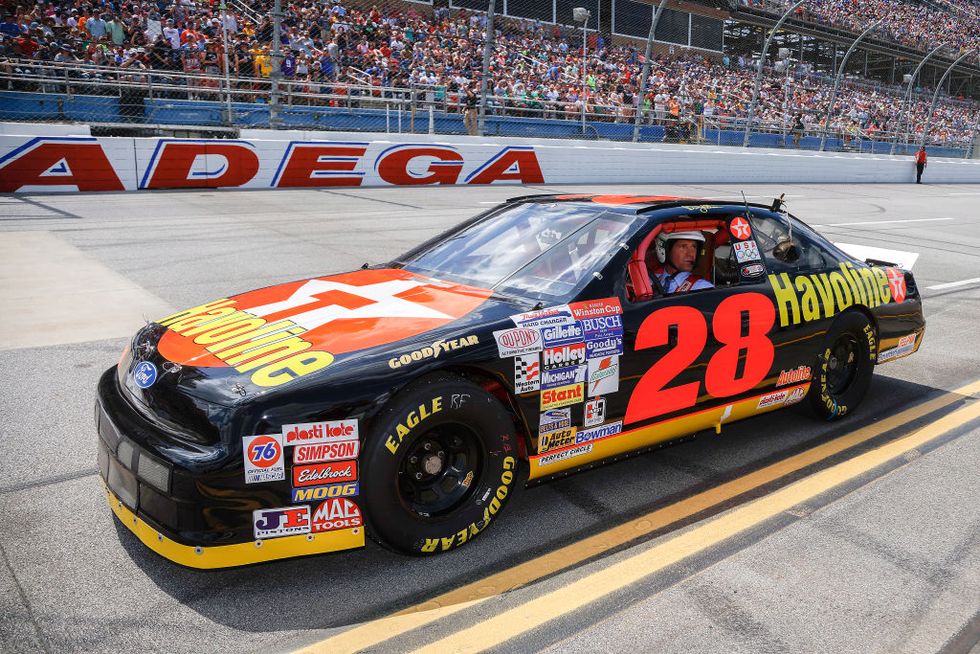Legend says Talladega Superspeedway was built atop sacred land taken from the Creek Nation in the 1830s. It also says a medicine man looked back and cursed the land for all time as his people were being force-marched from Alabama to Oklahoma. Considering everything that’s happened there since 1969, the “Talladega Curse” may have been more real than skeptics realized.
The massive facility that hosts the NASCAR Craftsman Truck Series and NASCAR Cup Series teams this weekend has suffered more than its share of tragic, bizarre, unprecedented, and unforgettable moments.
When officials finally grew tired of the “cursed” talk, they summoned a Native-American shaman from the nearby Poarch Creek tribe to “restore balance” to the land. In 2009, Robert Thrower mixed four local plants, burned them, then lifted the ashes to the winds at the start-finish line and prayed, “Let this talk of a curse be no more.”
A History Lesson as We Cross Our Fingers This Weekend
• Upwards of a dozen stars refused to run the first race because they didn’t trust the Goodyear and Firestone tires at 200-plus mph speeds. When NASCAR president and track owner Bill France Sr. refused to reschedule until tougher tires could be developed, many of his drivers loaded up and left early. The show went on after he paid lesser-known drivers from Saturday’s support race to stay and race on Sunday. With enough well-timed cautions to ensure tire safety, the first Talladega 500 was competitive and relatively uneventful;
• While leading in August 1973, former champion Bobby Isaac pulled in and told owner Bud Moore he was done, that he’d heard voices telling him to quit. It was first thought Isaac was uncomfortable having to race past the Turn 1 site where fellow Catawba, N.C. driver Larry Smith had crashed and died on lap 13, but Patsy Isaac said that wasn’t a factor.
“I don’t know what that experience was,” she said years later. “I don’t know if he felt an intuition or if it was actually a verbal voice. I know it impacted him enough that he wasn’t going to stay in the car. He always said it wasn’t because someone had gotten killed and that person was from Catawba, and he knew him.”
Isaac didn’t race Cup again that year, but had 19 more starts scattered over the next two years. Ironically, the Hall of Famer died of a heart attack after a Late Model race at Hickory, N.C. in August of 1977, four years and two days after the Talladega incident;
• Tiny Lund died in August 1975 in a race he didn’t expect to run. He landed a one-off with a mediocre team, but didn’t qualify. The race was rained out and postponed a week, when Lund likely would have been home, watching on TV. He returned when Grant Adcox withdrew after a crewman died of a heart attack, moving Lund from first alternate onto the 50-car grid. He died in a backstretch accident after just six laps;
• In May 1986, a 20-year-old man wormed his way to pre-race ceremonies at the start-finish line. With security lacking, Darion Crowder jumped in the Pontiac pace car and took off. He made a full 2.66-mile lap before being blocked in Turn 4 on his second time around. He was yanked from the car, taken to jail and later spent time in a state psychiatric facility. He died in 2016 at age 51;
• A dozen drivers have recorded their first Cup victory at Talladega, more than anywhere else. Richard Brickhouse won in 1969 and was seldom heard of again. Dick Brooks in 1973, Lennie Pond in 1978, Ron Bouchard in 1981, Bobby Hillin Jr. in 1986, and Phil Parsons in 1988 never won after their Talladega victory. First-timers who later won elsewhere: Davey Allison, Ken Schrader, Brian Vickers, Ricky Stenhouse Jr., Brad Keselowski, and Bubba Wallace;
• Talladega has seen plenty of spectacular accidents, including two with potentially catastrophic outcomes. Bobby Allison’s May 1987 frontstretch crash took down some fencing, injured several fans, and led to restrictor plates. And a last-lap crash involving Brad Keselowski, Carl Edwards, and Ryan Newman in April 2009 sent Edwards into the frontstretch fencing, spraying debris into the grandstands. Two of the eight fans injured were airlifted to area hospitals with nonlife-threatening injuries. The other six were treated for lesser injuries and released from the track’s medical facility;
• Front-row starter Mark Martin ran into pole-winner Jimmie Johnson before the October 2002 race even began. His Ford abruptly turned left on the second pace lap and slammed the right-front of Johnson’s Chevrolet. It was determined that Martin’s car had a hydraulic steering problem that locked up as he swerved to warm his tires;
• Race reports show several Talladega wrecks that involved at least 10 cars. Among them: a track-high 27 crashed together in 2003, two dozen crashed in both 2002 and 2012, and 21 crashed in 1973, the track’s first “Big One.” Despite the high speeds, close-quarter racing, and multi-car accidents, only Smith and Lund have died in Cup competition;
Then There’s These Off-Track Incidents
Davey Allison was killed and Red Farmer was injured in a 1993 helicopter crash in the paddock. … ARCA president Bob Loga died in a 1996 traffic accident in a parking lot. … Crewman Randy Owens died in 1975 when a pressurized water tank exploded in brother-in-law Richard Petty’s pit. … the mother of ARCA driver David Sisco was hit and killed as she walked through a parking lot in 1977. … the 2021 “noose” incident involving Bubba Wallace was big news until officials determined it wasn’t racially-motivated. … long-time Team Penske executive Don Miller lost his right leg in a 1974 pit accident. … nobody was ever caught after officials discovered cut tires, loosened oil lines, and sand in fuel tanks prior to a 1974 race.
The question: is Talladega Superspeedway truly cursed or has it simply been plagued by 55 years of bad luck?
Contributing Editor
Unemployed after three years as an Army officer and Vietnam vet, Al Pearce shamelessly lied his way onto a small newspaper’s sports staff in Virginia in 1969. He inherited motorsports, a strange and unfamiliar beat which quickly became an obsession.
In 53 years – 48 ongoing with Autoweek – there have been thousands of NASCAR, NHRA, IMSA, and APBA assignments on weekend tracks and major venues like Daytona Beach, Indianapolis, LeMans, and Watkins Glen. The job – and accompanying benefits – has taken him to all 50 states and more than a dozen countries.
He’s been fortunate enough to attract interest from several publishers, thus his 13 motorsports-related books. He can change a tire on his Hyundai, but that’s about it.
Read the full article here





